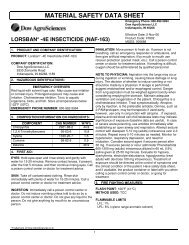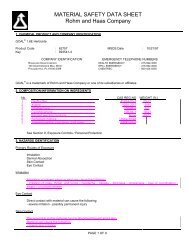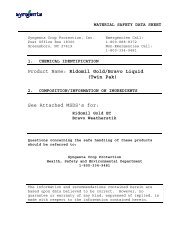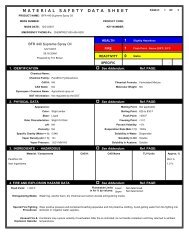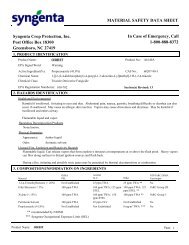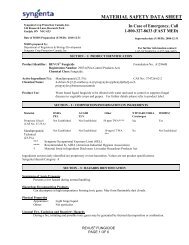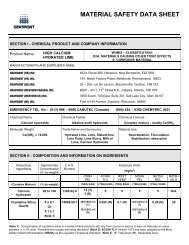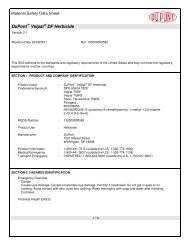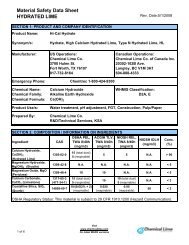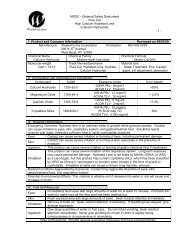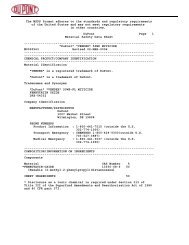csc 80% thiosperse - Martin Midstream Partners
csc 80% thiosperse - Martin Midstream Partners
csc 80% thiosperse - Martin Midstream Partners
You also want an ePaper? Increase the reach of your titles
YUMPU automatically turns print PDFs into web optimized ePapers that Google loves.
CSC <strong>80%</strong> THIOSPERSE<strong>Martin</strong> Operating <strong>Partners</strong>hip L.P.P.O. Box 191Kilgore, TX 75663For chemical emergency, spill, leak, fire, exposure, or accident,call Chemtrec - day or night 1-800-424-9300MATERIAL SAFETY DATA SHEET1. IDENTIFICATION OF PRODUCT Unusual Fire and Explosion Hazards: Contain runoff by diking to prevent contamination of waterManufacturer’s Name: <strong>Martin</strong> Operating supplies. Dusts may form explosive mixtures with<strong>Partners</strong>hip, L.P.air. TemperatureP.O. Box 191NFPA Hazard RatingKilgore, TX 75663Emergency Phone No: Chemtrec 0 Least(800) 424-9300 1 Slight 2 Health(24 hours) 2 Moderate 1 FlammabilityTrade Name 3 High I Reactivityand Synonyms: CSC <strong>80%</strong> Thiosperse 4 SevereChemical Nameand Synonyms: Sulfur Hazards Classification (40C FR370):Chemical Family: Sulfur Immediate Health: YESEPA RegistrationDelayed Health: NONumber: 55429-4 Fire: YESSudden Pressure: NO2. PRODUCT COMPONENTS Reactivity: NOSection 313 (40CFR372): This product contains theComponent: % Threshold Value following chemicals subject to SARA Section 313(units):reporting requirements: Sulfur.Sulfur(CAS No. 7704-34-9) 80.0 None established 5. REACTIVITY INFORMATIONContains no substancesStability: Stablelisted as toxic by SARAConditions to Avoid: Strong oxydizers313. Contains no substances Hazardous Decompositionknown to be carcinogens. 20.0 — Products: NoneHazardous Polymerization: None3. PHYSICAL INFORMATION Conditions to Avoid: Open flames, sparks, ignitionsourcesAppearance and Odor: Solid amber crystals,characteristic odor6. HEALTH INFORMATIONSolubility in Water: InsolubleBulk Density: 30 -40 lbs./cu.ft.Melting Point: 115 °C/214 °FToxicological Test Data:Oral (Acute)LD50> 2,000 mg/kg4. FIRE AND EXPLOSION HAZARD INFORMATION Dermal (Acute)LD50> 2,000 mg/kgFlash Point (test method): 207 °C (INRS)Inhalation (Acute)Flammable Limits:LC~,> 1.35 mg/L (4HR)(percent by volume): None establishedChronic, Subchronic, etc.Fire Extinguishing Media: Dry chemical, carbonThere are no known risks of oncogenic,dioxide, foam, water spray or fogteratogenic or reproductive hazardsAuto Ignition Temperature: 232 °Cassociated with sulfur.Special Fire Fighting Procedures: Use self-containedbreathing apparatus.CSC8OT.915
Effects of Overexposure: Route of entry: ingestion,EPA HANDLER REQUIREMENTSinhalation, eyes and skin contact. Most likely route ofWorker Protection Standardentry: dermal, inhalation. Product is considered to be 40 CFR 170of low to moderate toxicity. May be harmful ifswallowed or inhaled. May cause irritation of eyes,Note: the following PPE requirements addressnasal passages, throat and skin. Prolonged orhandler/applicator requirements under FIFRA and mayrepeated exposure may increase irritation, particularly differ from what is felt necessary to address a clean up,to eyes and mucous membranes. Overexposure can needs during formulation/manufacturing or other times oflead to nausea, diarrhea, gastrointestinal distress,involvement with the product.headaches, weakness, and in severe cases possiblePersonal Protective Equipment: Applicators andliver and kidney damage.other handlers must wear long-sleeved shirt and longEmergency and First Aid Procedures: Call apants, chemical-resistant gloves, and shoes plus socksphysician immediately in all cases of suspectedFollow manufacturer’s instructions for cleaning andpoisoning,maintaining PPE. If no such instructions for washables,Ingestion: Induce vomiting; give plenty of water.use detergent and hot water. Keep and wash PPEEyes: Flush with plenty of water for at least 15 minutes separately from other laundrywhile holding eyelids open. If irritation persists, getmedical attention.9. SPECIAL PRECAUTIONSSkin: Remove all contaminated clothing. Wash skinand hair thoroughly with soap and water. WashHandling and Storage: Store in a cool, dry placeclothing before reuse.away from children, food and feed products. Keep workInhalation: Remove to fresh air. If irritation persists, and storage area cleanget medical attention.Other Precautions: Toxic to fish and other aquaticorganisms.Medical Conditions Aggravated by Exposure:Preexisting skin or respiratory disorders may be10. REGULATORY INFORMATIONaggravated by excessive exposure to this material.SARA TITLE Ill HAZARD CATEGORY:Potential Carcinogen Status: None listed by IARC, Immediate: YESNIP or OSHA.Delayed: NOFire: YES7. SPILL OR LEAK PROCEDURES Reactive: NOSudden Release of Pressure: NOSteps to Be Taken in Case Material is Leaked orSpilled: Contain spill; vacuum, scoop or sweep up and SUBSTANCES REGULATED UNDER SARA, TITLEplace in container for disposal. Ill, SECT. 313:Waste Disposal Method: Check local, state andFederal regulations for disposal. DATE OF ISSUE: 1/01/20058. SPECIAL PROTECTION INFORMATION All information contained in this Material Safety DataSheet is furnished free of charge and is intended for yourProtective Clothing:evaluation. In our opinion the information is, as of the dateEye Protection (Type): Safety gogglesof this Material Safety Data Sheet, reliable; however, it isGloves (Type): Rubber glovesyour responsibility to determine the suitability of theRespiratory Protection: If dusts exceed acceptable information for your use. You are advised not to construelevels, or if irritation occurs, wear MSHA/NIOSH-approved the information as absolutely complete since additionalmask or respirator for protection against pesticide dust. information may be necessary or desirable whenOther Clothing: Long-sleeved shirt and long pants, particular, exceptional or variable conditions orshoes and socks.circumstances exist or because of applicable laws orVentilation:government regulations. Therefore, you should use thisLocal Exhaust: Provide in confined areasinformation only as a supplement to other informationMechanical (General): If ventilation is not adequate, gathered by you, and you must make independentprovide ventsdeterminations of the suitability and completeness of theSpecial: Not normally requiredOther: Work in a well-ventilated areainformation from all sources to assure both proper use ofthe material described herein and the safety and health ofemployees. Accordingly, no guarantee expressed orimplied is made by Continental Sulfur Company, LLC as tothe results to be obtained based upon your use of theinformation nor does Continental Sulfur Company, LLCassume any liability arising out of your use of theinformation.CSCSOT.9 15



